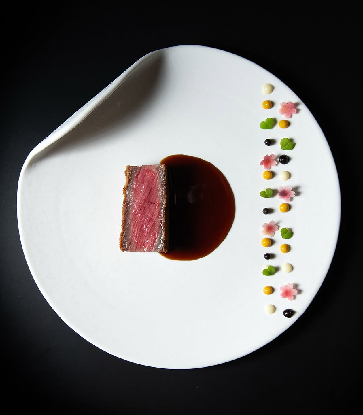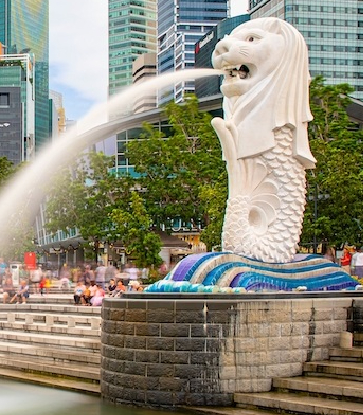Over the past five months, four fine-dining restaurants have shuttered. Two-Michelin-starred Restaurant Andre closed in February after intriguing diners eight years with its Nouvelle French cuisine. Four months later, three-Michelin-starred French restaurant Joel Robuchon and its sister two-Michelin-starred restaurant, L’Atelier de Joel Robuchon, dropped the bombshell that their last day in Resorts World Sentosa was on 30 June, though the latter may reopen in a new location.
A week later, Hashida Sushi, a five-year-old acclaimed Japanese restaurant in Mandarin Gallery also announced that it too was calling it quits. Hot on the heels of these closures, Italian restaurants Osteria Mozza and Pizzeria Mozza, both linked to American celebrity chefs Nancy Silverton and Mario Batali, will serve their last meals on 27 July after eight years in Marina Bay Sands (MBS).

Industry players, from restaurateurs, chefs and real estate analysts, whom the MICHELIN Guide Digital spoke to, are resigned to the challenging reality of opening and operating a fine-dining restaurant in Singapore, but they are not overly concerned as there isn’t an overlying reason behind the recent spate of closures.
Chef Andre Chiang of Restaurant Andre expressed a desire to return to his home country of Taiwan, where he has a one-Michelin-starred restaurant, RAW. He also wants to focus on boosting food education among young chefs in Asia while juggling restaurant projects in the region. For the closure of the Joel Robuchon restaurants here, a media report emerged that it might be linked to its location and costs of importing high quality produce. Hashida Sushi’s chef Kenjiro Hashida will venture to San Francisco’s Hotel Abri next month with a new restaurant. While MBS did not address the recent sexual misconduct allegations surrounding Batali, a spokesperson says: “In the dynamic culinary world, nothing stands still. MBS continues to be in the search for great new culinary partners in our next lap of growth.”

Agreeing with Han is Michel Lu, executive chairman of boutique consultancy Revolver Asia that specialises in food and beverage businesses, thinks that these closures should
not define the outlook of an entire industry. He says: “Of the recent closures, at least one closed down to a lack of business, the rest are due to restructuring or a change in direction from the chefs.”
Some chefs view these departures as part and parcel of surviving in a dynamic and competitive dining landscape.
Beppe de Vito, chef-restaurateur of the ilLido Group, which runs restaurants, including the one-Michelin-starred Braci, calls these closures a “natural evolution”. He says: “Most restaurants here last for an average of three years before they see an increase in rental rates. One needs to figure out the equation of growing the business and staying profitable while developing the talent in the company.”
Sustaining a fine-dining restaurant in Singapore is challenging due to the high costs involved, from importing seasonal ingredients to training quality staff to deliver top-notch dining experiences.
Loh Lik Peng, founder of hospitality group Unlisted Collection that runs 14 restaurants in Singapore, says: “The profit margins of fine-dining restaurants is a single digit percentage due to the fixed overheads of everything from food and labour to even water.” He adds that restaurants in Hong Kong receive sufficient business to operate seven days a week, but those in Singapore, they function more on a five-day-a-week basis.
Despite this gloomy prospect, Loh plans to continue opening fine-dining restaurants here. “I am a fool who opens fine-dining restaurants for the passion of enjoying good food,” he adds with a chuckle. “You just hope to make a little bit of money or break even.”

The most common problem that most of the industry players interviewed face is the limited market of local diners and tourists to support the Singapore’s fine-dining scene. Ignatius Chan, founder of one-Michelin-starred Iggy’s, observes that the market of fine-dining customers is “way too small” and not enough to sustain the volume of restaurants here.
He says: “European-style gastronomy restaurants are flourishing in cities like London, where you need to reserve at least three or four days in advance. But in Singapore, diners may also go for other cuisines such as Chinese and Japanese. They are also spoilt for choice with new restaurants.”
Chan also noticed that Iggy’s has been receiving fewer tourists from Europe and the United States since 2016. He adds: “Six or seven years ago, the restaurant was constantly filled. But these days, business can be erratic. On some days, only a few tables are occupied, while the restaurant can have a full house on other days.”
““Singapore diners have the palate but not the wallet when it comes to fine-dining. They tend to mix up worth with value.” — Desmond Sim, head of research for Singapore and South-east Asia at CBRE”
Desmond Sim, head of research for Singapore and South-east Asia at CBRE, a real estate services company, says: “Singapore diners have the palate but not the wallet when it comes to fine-dining. They tend to mix up worth with value.”
He adds that this could be due to the “diverse gamut of food choices” here as a one-Michelin-starred meals can range from $3.80 for a plate of soya sauce chicken rice to $300 for a fine-dining meal. Local diners, he observes, only visit fine-dining restaurants on special occasions or when they can charge their meals to corporate accounts. “It is a niche and transient market that depends on waves such as the Formula 1 racing season.”
Echoing this sentiment is Han, who says: “Singapore diners need to put their money where their mouth is.”
On the mentality shift needed for Singaporeans to pay good money for good food, he adds: “Singaporeans are foodies but they need to be willing to pay for good, creative food, or else it becomes a vicious circle of restaurants closing due to lack of money to get quality ingredients and staff, and operations come under duress.” His advice? “Come with an open mind and be happy to spend to eat before forming an opinion.”

The limited pool of well-trained service staff — maitre d’s, chefs and sommeliers — is something that restaurateurs have to grapple with constantly. Long working hours and stagnant wages have made the sector unattractive over the years. Restaurants are also slapped with foreign worker restrictions, which pegs the number of foreign workers to the number of full-time local employees.

He shares with a laugh: “I was dining at Arzak in San Sebastian recently and the wait staff, whom I met 15 years ago, was still there.”
Agreeing with Chan is Han, who says that the hiring landscape for fine-dining restaurants is “an employees’ market”, which sees well-trained staff being in-demand. He shares: “ I have to deal with both the increased manpower costs and a shortage of manpower. Due to this employment system, Singaporean are asking for more pay as they know that they are needed in order for us to hire more foreigners.”
To curb this problem, De Vito suggests introducing temporary work passes for young adults, like diploma students from South-east Asia, to work in restaurants here for one or two years.

Market and manpower aside, factoring in food costs is crucial for fine-dining restaurants, which pride themselves on using premium ingredients such as foie gras, black truffle and imported seasonal seafood and vegetables. De Vito says: “Fine dining cuisine comprises more complicated cooking techniques and more culinary precision. More research and testing of food are required to find ways of transforming dishes innovatively.” He estimates that food costs can take up at least 35% of a fine-dining restaurant’s operation costs.
That’s why it is crucial to get the financial backing of restaurant investors and partners to support the high costs of running a fine-dining restaurant. An industry insider, who declines to be named, says that restaurant partners must be willing to invest in “high quality ingredients and staff training in order to maintain service and food excellence”.
Chan says that he manages operational costs of Iggy’s by keeping his team tight with just four service staff. He and his wife, Janice, step in regularly to help out with the service. The restaurant also sources wines efficiently by going to the source to minimise overheads while not losing profit margins.
In addition, Sim notes that rental for a fine-dining restaurant can take 40 to 50% of a restaurant’s operating costs and the market plays in favour of property landlords. He explains that restaurants in shopping malls see their rents increase over time, as malls are usually owned by REITs, which tend to prospect favourable returns and have to meet the Return on Investment.
Potential solutions for escalating rental rates include longer leases and a more flexible rental rate system based on turnover performance of the restaurant.

The Future Of Fine Dining
With the recent series of closures, will Singapore’s reputation as a gastronomy hub in Asia be tarnished? Most industry players are cautiously optimistic, believing that with every restaurant closure, another newcomer is waiting to take its place.
Some prominent names that are opening restaurants here include celebrity chef Alain Ducasse, who will open a restaurant in Raffles Hotel next year, and British chef Marco Pierre White, who will open The English House in Mohamed Sultan Road. Last month, local celebrity chef Justin Quek opened a modern Asian fine-dining restaurant Chinoiserie at MBS.
Han says that the gap left by Joel Robuchon, which was Singapore’s only three-Michelin-starred restaurant, will motivate more restaurants to up their game and continue flying the Singapore flag in the world’s fine-dining arena.
He hopes that this episode can drive home the importance of supporting Singapore cuisine and home-grown talent. He says: “Much as I love diversity, foreign chefs have the option of going back to their home countries or elsewhere for projects. We are here to stay in Singapore.”
““Much as I love diversity, foreign chefs have the option of going back to their home countries or elsewhere for projects. Local chefs are here to stay in Singapore.” — Chef Han Liguang of Labyrinth”
De Vito, who will open Benih, a 12,000 sq ft restaurant-cum-research centre that uses local ingredients next year, says: “Restaurants need to keep evolving, by studying how to stand out from others and give customers an element of surprise in their dining experience to get them coming back. Restaurant should be casual yet professional, without the stuffiness of dining with table cloths and scary concepts of $300 to $400 a menu.”
However, some are less optimistic. Chan thinks that these exits have put a damper on Singapore’s image as a top gastronomy capital in Asia. He says: “We used to be the top dining destination in Asia but we have been overtaken by cities such as Bangkok, Hong Kong and even Taipei.”
Sim adds that the status of Singapore’s fine-dining scene depends on the performance of the next wave of fine-dining restaurants opening here. He concludes: “There are still good restaurants here, but if these fail, Singapore will lose its competitiveness as a gastronomy hub.”
RELATED: Last Dinners: Why Are These Top Restaurants Around The World Closing Down?
Made with Visme Infographic Maker






















